See how a stockpile of customized Gibsons and worn-down Nash Ps provide an intergalactic prog-rock soundtrack to The Amory Wars. Plus, Claudio Sanchez drops news about a Muff-and-Super-Overdrive clone collaboration with Wren and Cuff.
It’s common for prog bands to create a fictitious narrative for their concept albums. Often, the lyrics tell a linear story, while the adventurous, experimental, and elevated musicianship provides emotional support and dynamism to the album’s arc. Some ambitious wordsmiths may even spread their yarn over two albums or releases, but Coheed and Cambria’s Claudio Sanchez has penned an entire science fiction tale called The Amory Wars that has been transcribed in comic books and graphic novels published by Evil Ink Comics. All but one of the band’s 10 albums, including the brand-new Vaxis–Act II: A Window of the Waking Mind swim in his solar system called Heaven’s Fence—a collection of 78 planets and seven stars wholly envisioned by Sanchez. (The Color Before the Sun, from 2015, is the lone release not centered in The Amory Wars universe.)
Crafting a daring soundtrack for these narratives requires an equally bold group of musicians. Through two decades, this fearless foursome have incorporated prog orchestrations, synth flourishes, pop-punk hooks, menacing metalcore, hardcore aggression, and electronica ballads—and yet it’s always felt like Coheed. No matter the direction they turn or how their colors and hues shift, it’s unmistakable. Having no genre allows for all genres.
It’s worth noting the band’s name is lifted from two main characters in The Amory Wars. Their original name in the late ’90s was Shabütie, and that trio (consisting of guitarist/vocalist Sanchez, bassist Michael Todd, and drummer Nate Kelley) released three EPs before rebranding for Coheed’s 2002 debut, The Second Stage Turbine Blade, released on Equal Vision Records. That first Coheed lineup included the Shabütie carryovers of Sanchez and Todd, and welcomed guitarist Travis Stever and drummer Josh Eppard. (The earliest incarnations of Shabütie included Stever, too.) The band’s current lineup has been solid since 2012, when bassist Zach Cooper joined.
Coheed’s headlining 2022 run is a dual celebration. They’re honoring the 20th anniversary of their debut and the just-released Vaxis–Act II: A Window of the Waking Mind. Before their July 23 show at Nashville’s Municipal Auditorium, PG’s Chris Kies hosted conversations that covered upgrading Gibsons, overhauling an entire bass rig during shutdown, and how a stolen Big Muff eventually led to a signature sound and pedal.
Brought to you by D'Addario XPND Pedalboard.
A Golden Accident
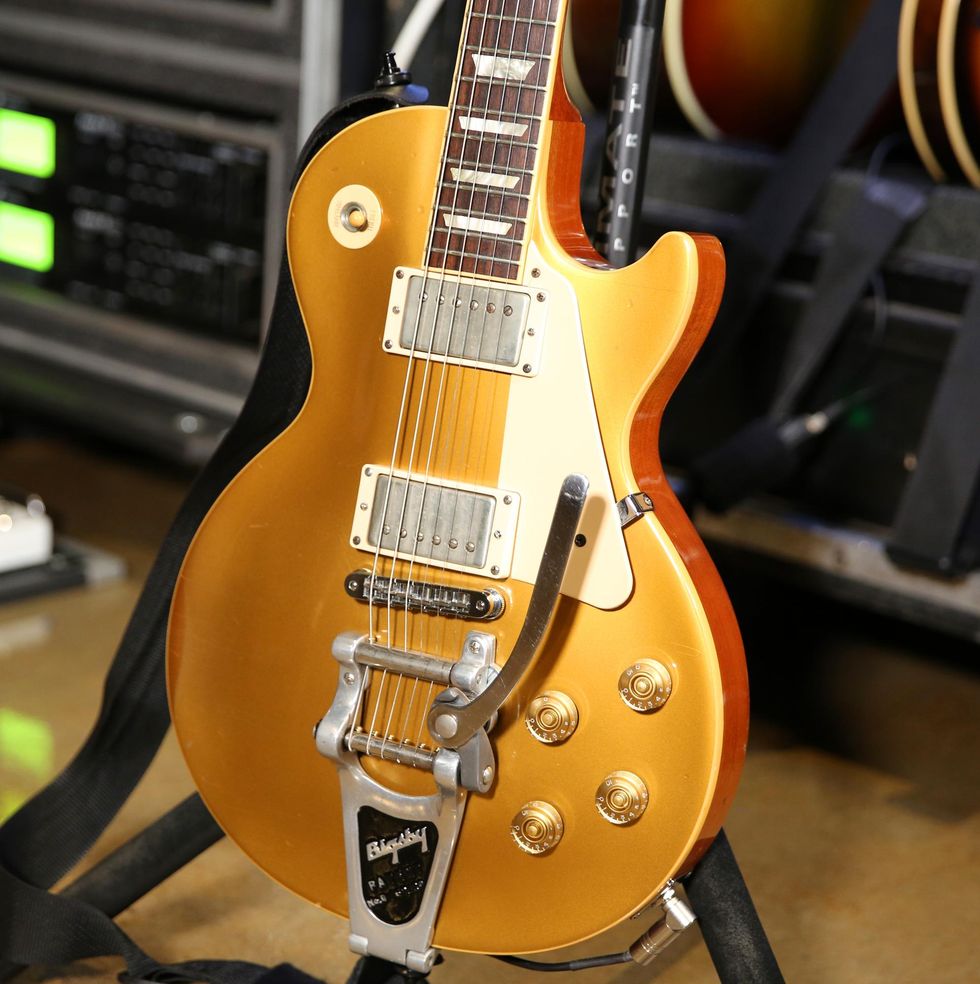
In a recent Big 5 video for PG, Coheed and Cambria’s Travis Stever held up this Gibson Les Paul Standard goldtop as his favorite guitar, even though this was a free throw-in from Gibson for a custom order we’ll see in the next slide. He favors this Les Paul to the rest of his Gibsons because it’s heavy in sound and stature. “It gives me something to grab onto,” comments Stever.
He’s since upgraded it with a set of Gibson ’57 Classic Plus pickups and a Bigsby vibrato. (All of Travis’ axes have either ’57 Classic or ’57 Classic Plus humbuckers except for one Gibson we’ll meet in a minute.) He uses Ernie Ball Skinny Top Heavy Bottoms (.010–.052) on all his electrics and hammers away with custom Dunlop Tortex picks.
The World in My Hands
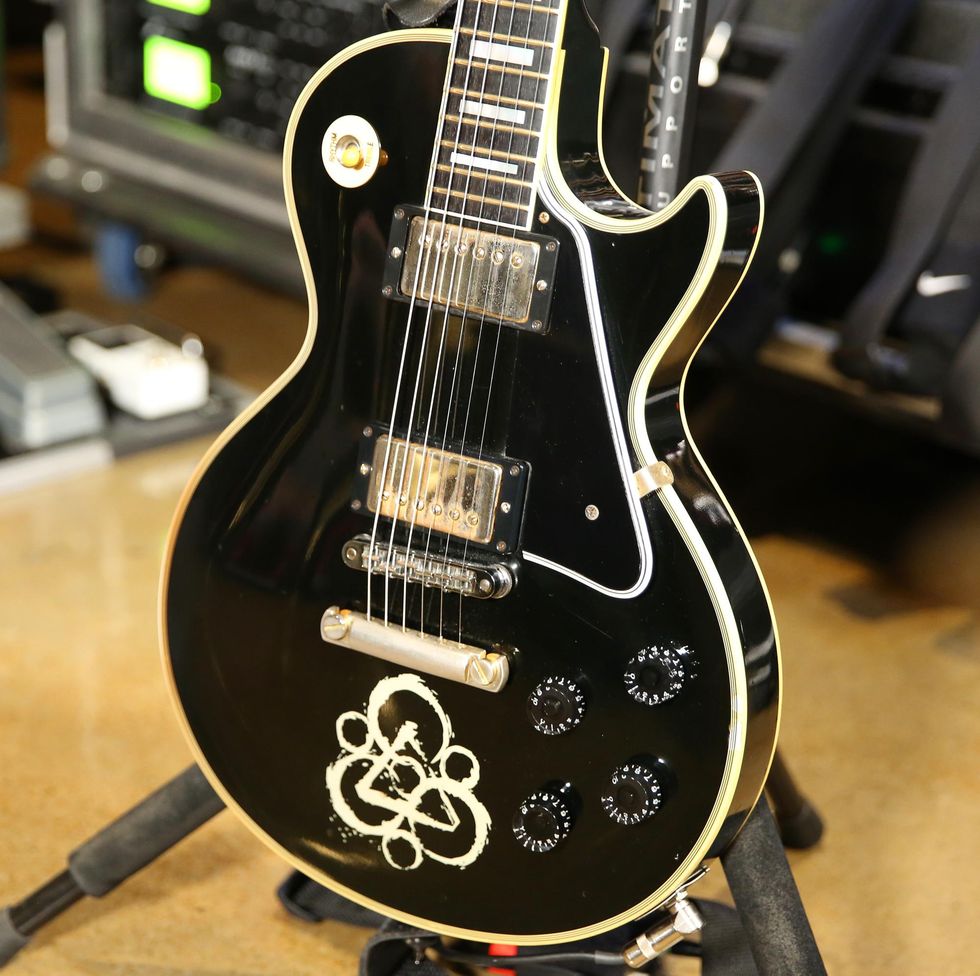
“Growing up, a friend of ours’ father had a ‘Black Beauty’ Gibson Les Paul, and I remember whenever I picked that guitar up, I felt I had the world in my hands, so I always wanted one,” summarizes Stever. When the opportunity to order a Les Paul Custom introduced itself, Stever decided to make it extra special by requesting the body have the“Keywork” engraved on its top. The “Keywork” is the band’s defacto logo that symbolizes the energy stream among the planets in the fictional Heaven’s Fence universe.
It’s Not a Sticker!
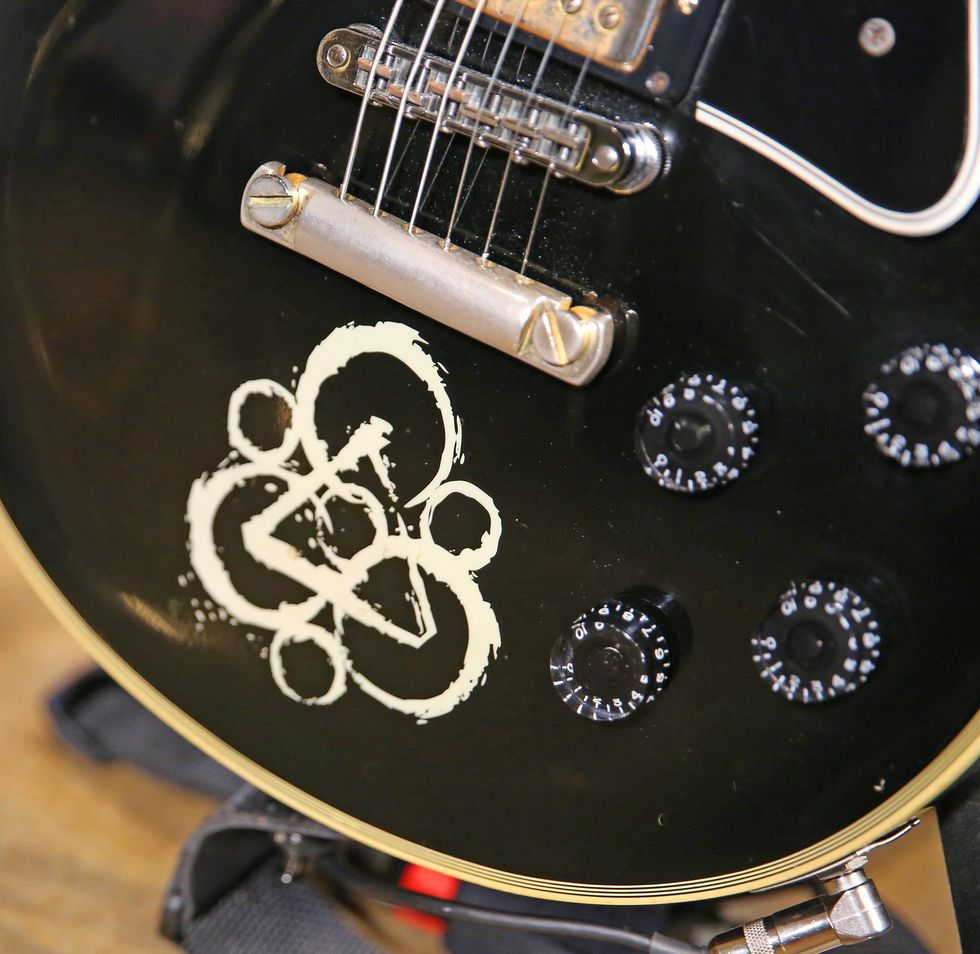
A detailed closeup provides scratchy evidence that the Keywork logo is etched into the top and not a resilient sticker.
Slim but Sturdy
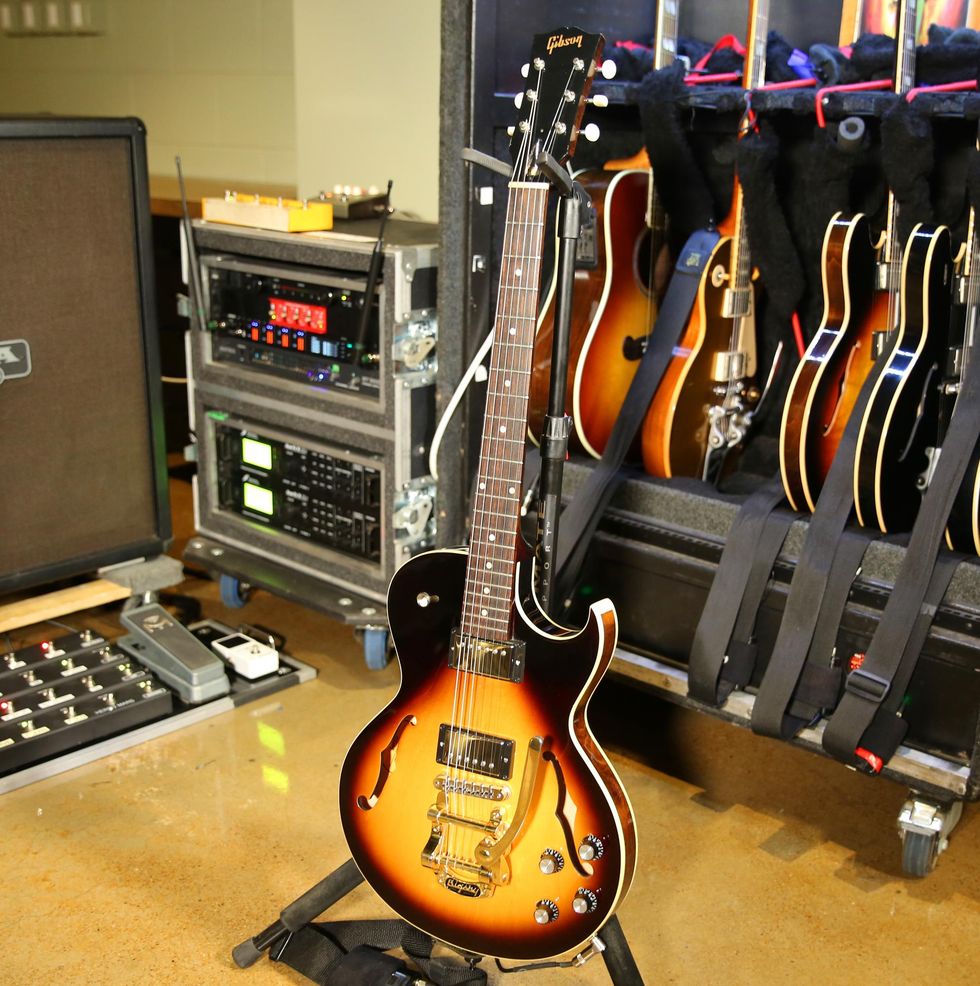
Here is Stever’s Gibson ES-137—reserved for the heaviest songs like “Beautiful Losers” and “Toys,” and tuned to drop D. The svelte semi-hollow has a mahogany center block running through its core, giving it some Stever-needed heft. This one still has its stock Gibson 490R and 498T humbuckers.
Balancing Bigsby
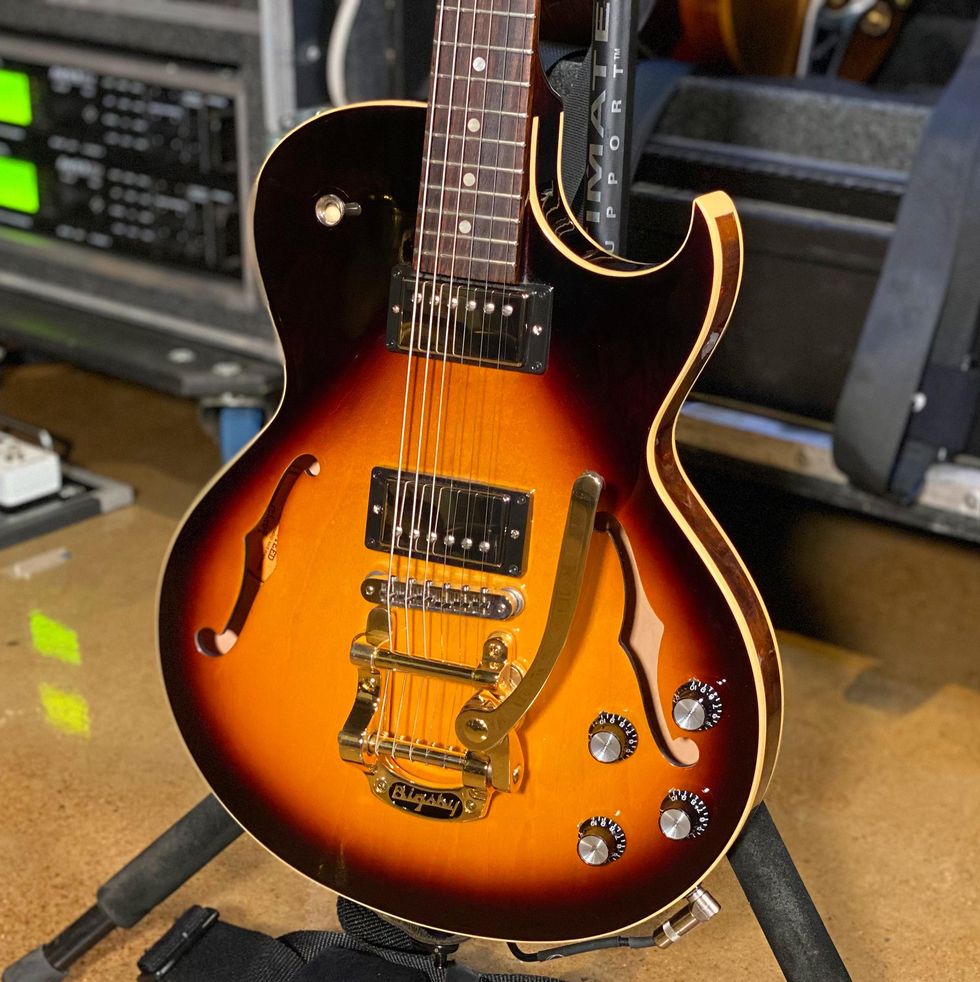
Stever’s crafty tech Ryan Ashhurst added the gold Bigsby to the 137’s slightly carved top. If you look closely, you’ll notice the back end of the tailpiece is floating off its curved shell.
Nothing Else Matters
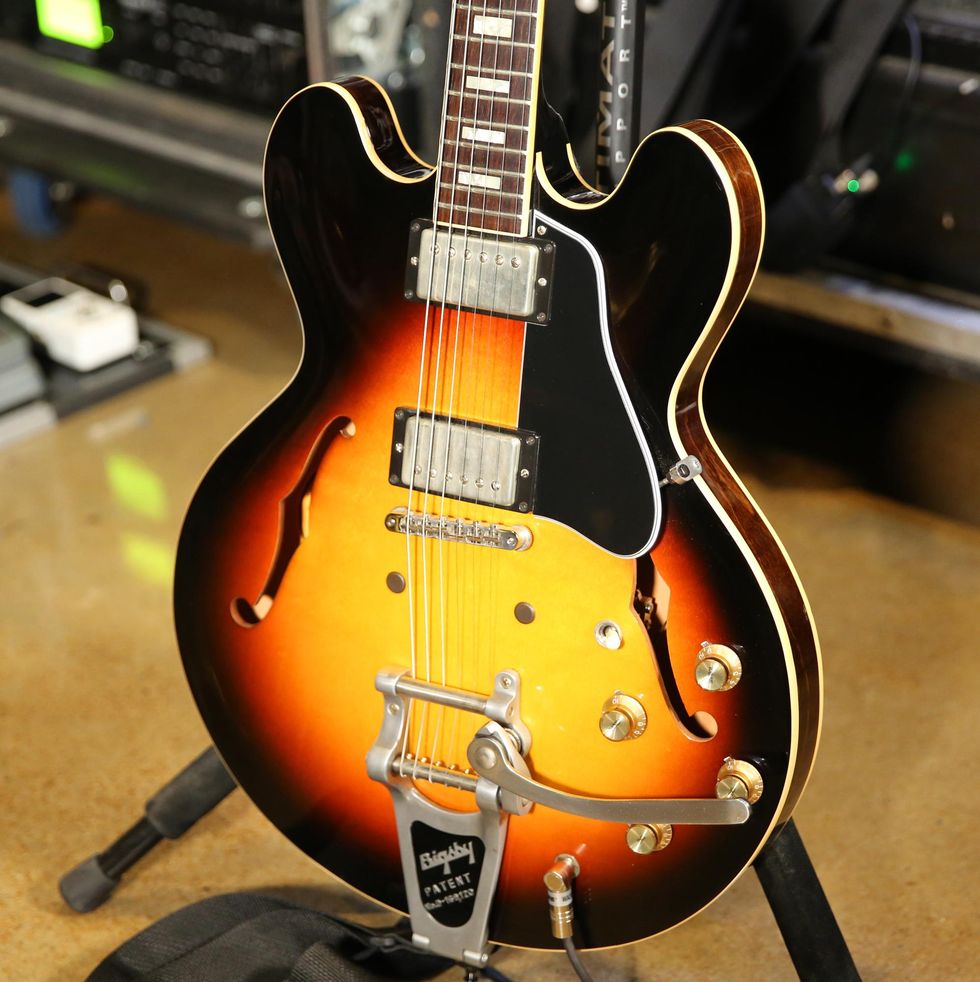
While recording 2018’s Vaxis–Act I: The Unheavenly Creatures, Travis took a break from tracking and went to a Guitar Center in Paramus, New Jersey, to clear his head. He fooled around with this Gibson ES-335 and in a blink 90 minutes went by. “When I go to a guitar store, I still like to keep a mindset of a kid where all my dreams can come true through this instrument,” admits Stever. “I played a red ES-335 for so long at that store that nothing else mattered.” He didn’t leave the shop that day with a new friend, but he quickly went online to Chicago Music Exchange and ordered the above sunburst 335. It currently gets stage time for “Blood Red Summer.”
Backup Beauty
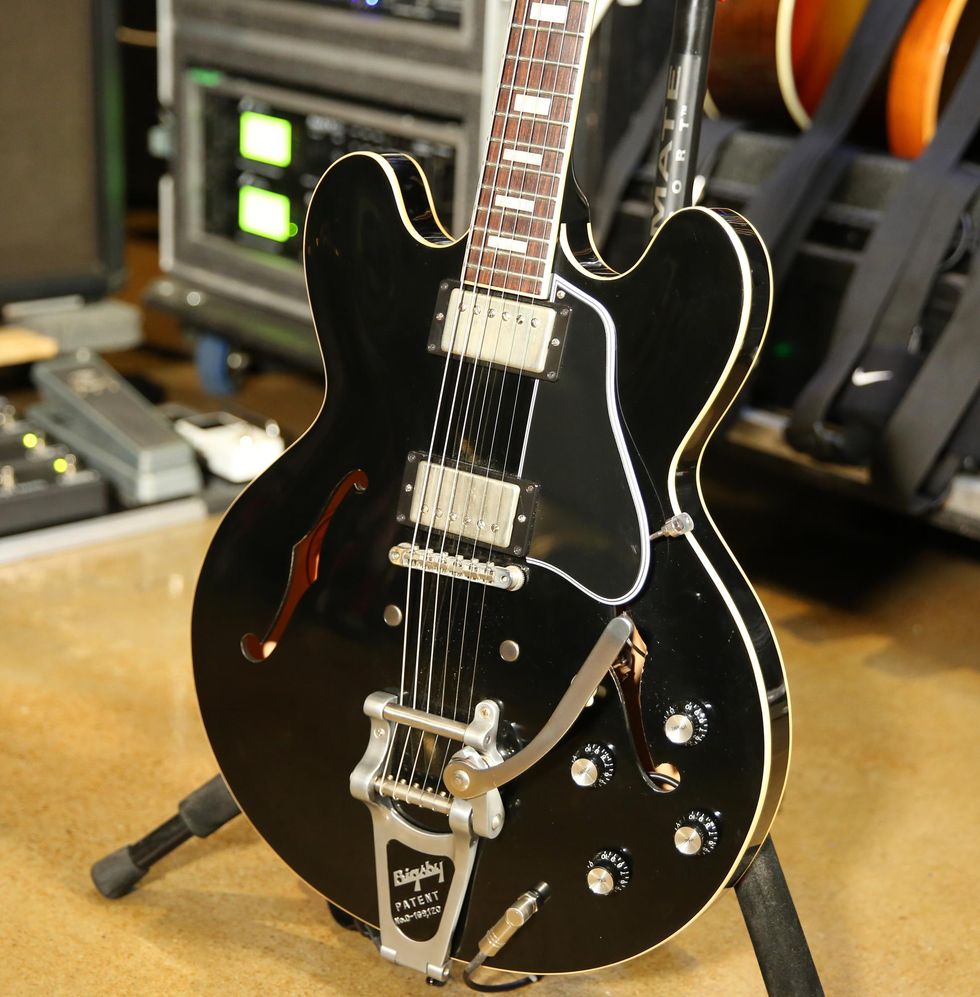
This classy-looking ES-335 is a backup for the previous sunburst model.
Sunburst Sidekick
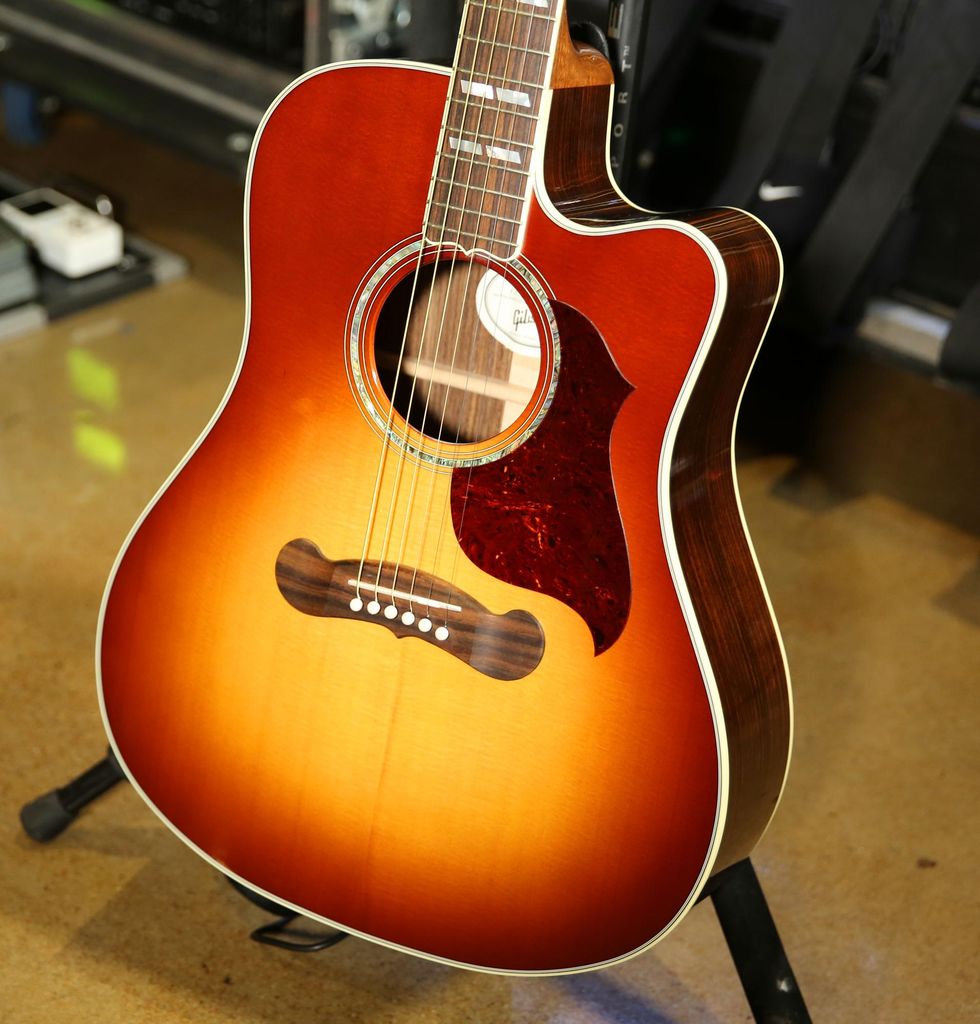
This snazzy acoustic is a Gibson Songwriter Standard EC Rosewood that Travis busts out for the pre-show VIP performance of the song “Our Love” off Vaxis–Act II: A Window of the Waking Mind.
Don’t Think About It
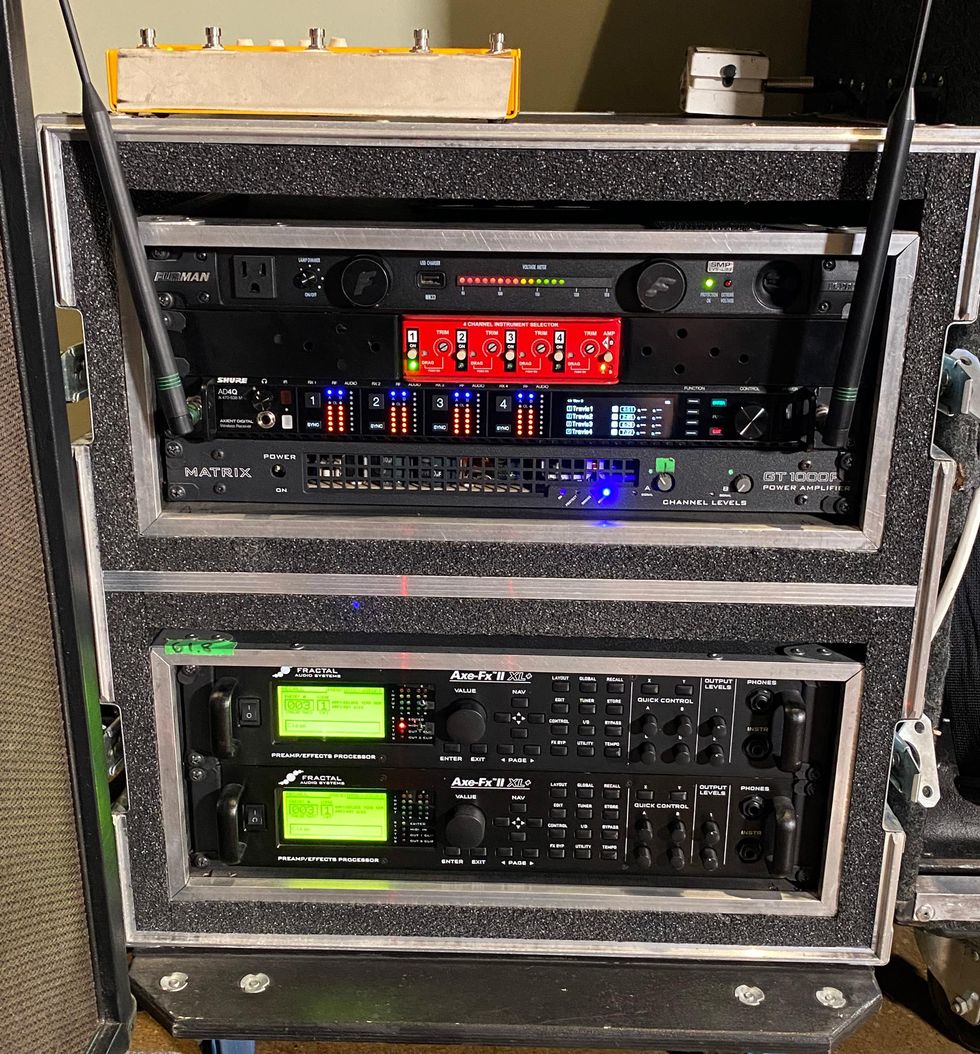
When we filmed with Coheed in 2013, they were an early adopter of the Fractal Audio Axe-Fx II. This is that same unit. In our new Rundown, Stever admits that his core patches haven’t changed in seven or eight years, and everything is based around the Mesa/Boogie Mark V. A Matrix GT1000FX powers the cabinet. All his guitars run through a Shure AD4Q wireless that splinters into four inputs thanks to the Radial JX-42 guitar and amp switcher. (Not pictured: The JX-42 is controlled by a Radial JR-5 remote.)
Four on the Floor
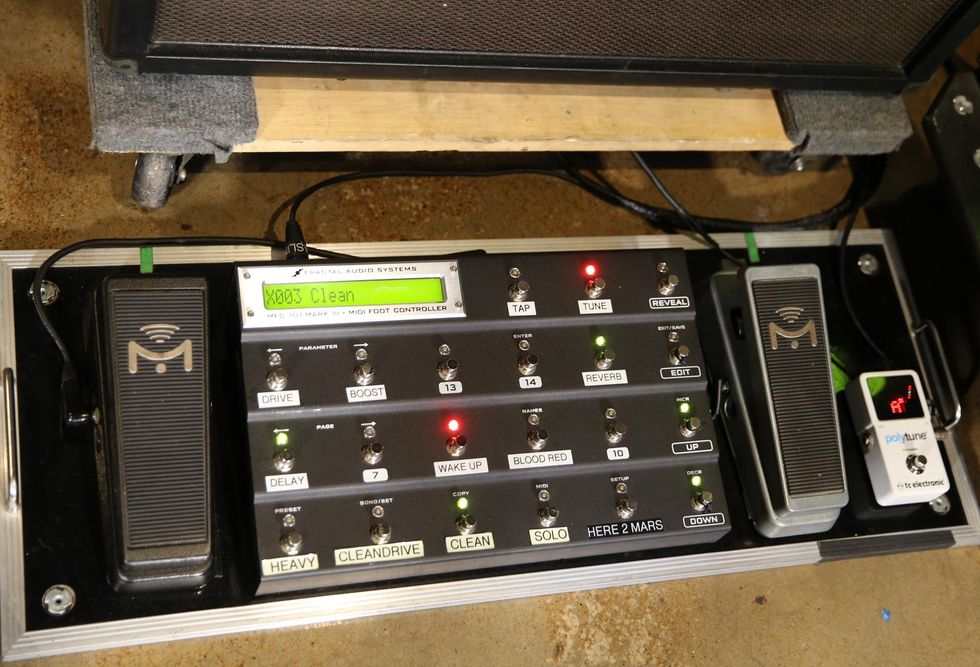
Here’s how Stever controls everything with his feet: a pair of Mission Engineering foot pedals (a VM Pro at left and an EP-1 on the right), a Fractal Audio MFC-101 Mark III MIDI foot controller, and a TC Electronic PolyTune.
“I’m a Bit Outrageous…”
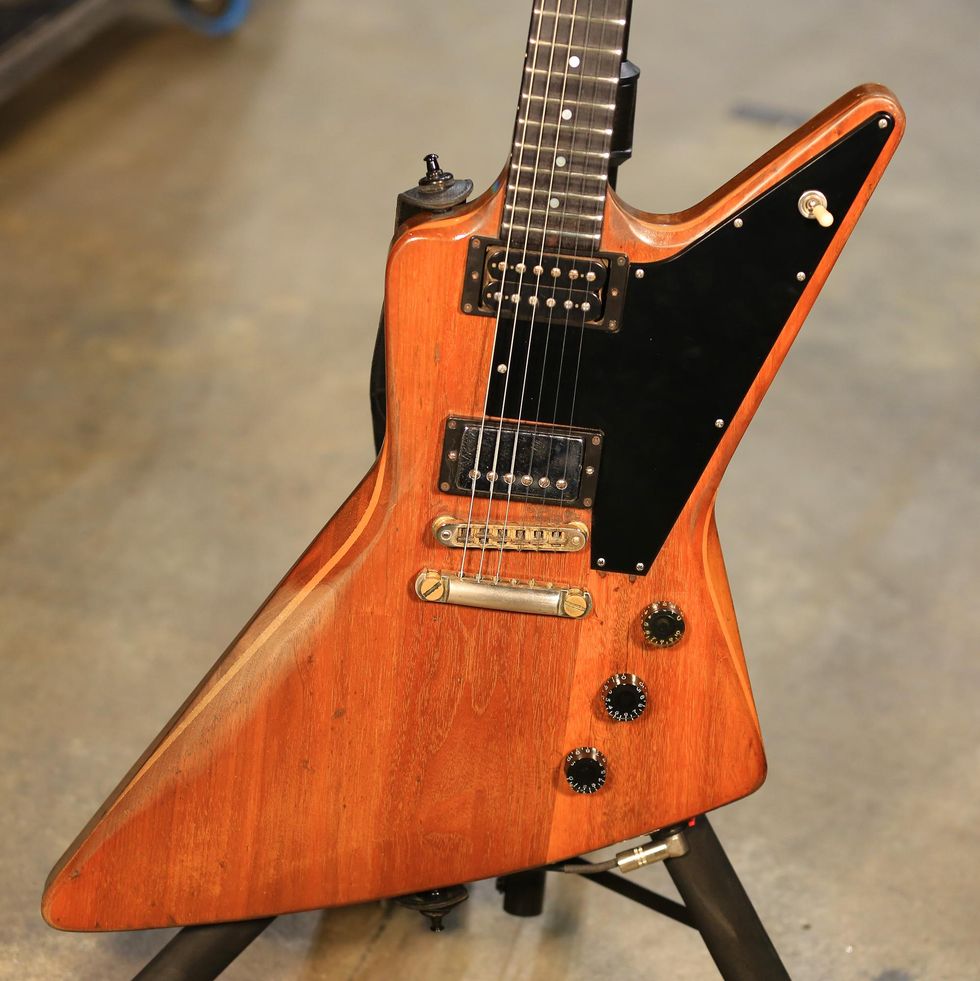
“James Hetfield plays an Explorer. An Explorer is kind of outrageous. I’d like to think I’m a bit outrageous, so I got it,” admits Claudio Sanchez. The creator and visionary behind The Amory Wars narrative favors a space-age instrument for his stage persona. His longtime squeeze is a 1980 Gibson Explorer E2 that left the Kalamazoo factory on his brother’s birthday (01/04/1980). He scored it at Mike’s Music in Cincinnati, Ohio, before a gig at nearby Bogart’s. He found it tucked in the shadows behind a big Ampeg SVT stack. As with all of Sanchez’s live guitars, he puts a Bare Knuckle Nailbomb humbucker in the bridge. This particular Explorer got an upgraded TonePros LPM04 Tune-o-matic bridge and tailpiece. And all his electrics take Ernie Ball 2240 Regular Slinky RPS strings (.010–.046).
Arm & Hammer
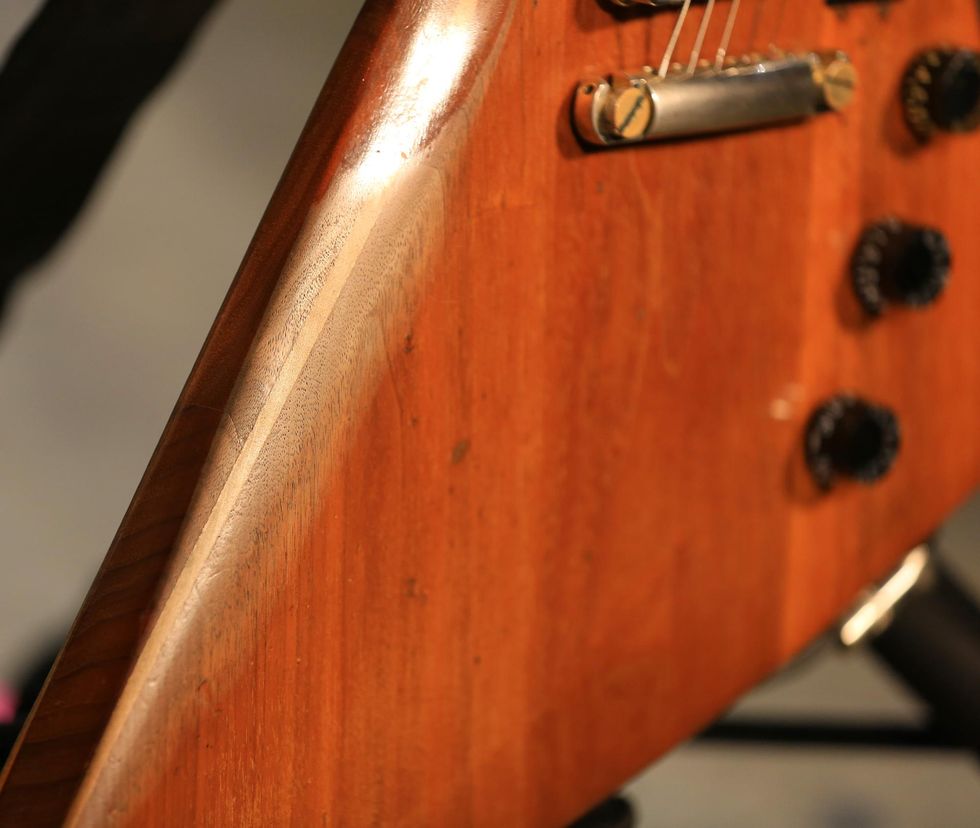
Check out the wear and tear Sanchez puts to the body of his No. 1 E2.
Can’t You See Me Looking?
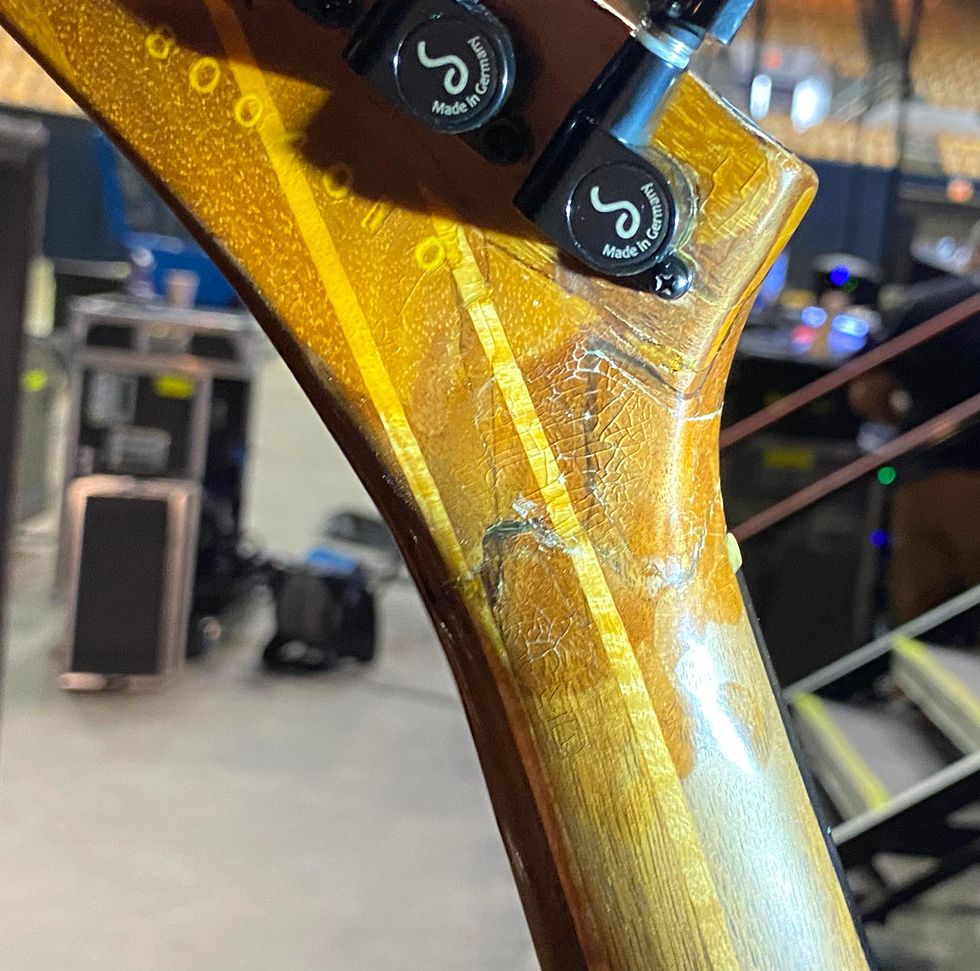
The E2 headstock has spent plenty of time in the ER.
E2 Part Deux
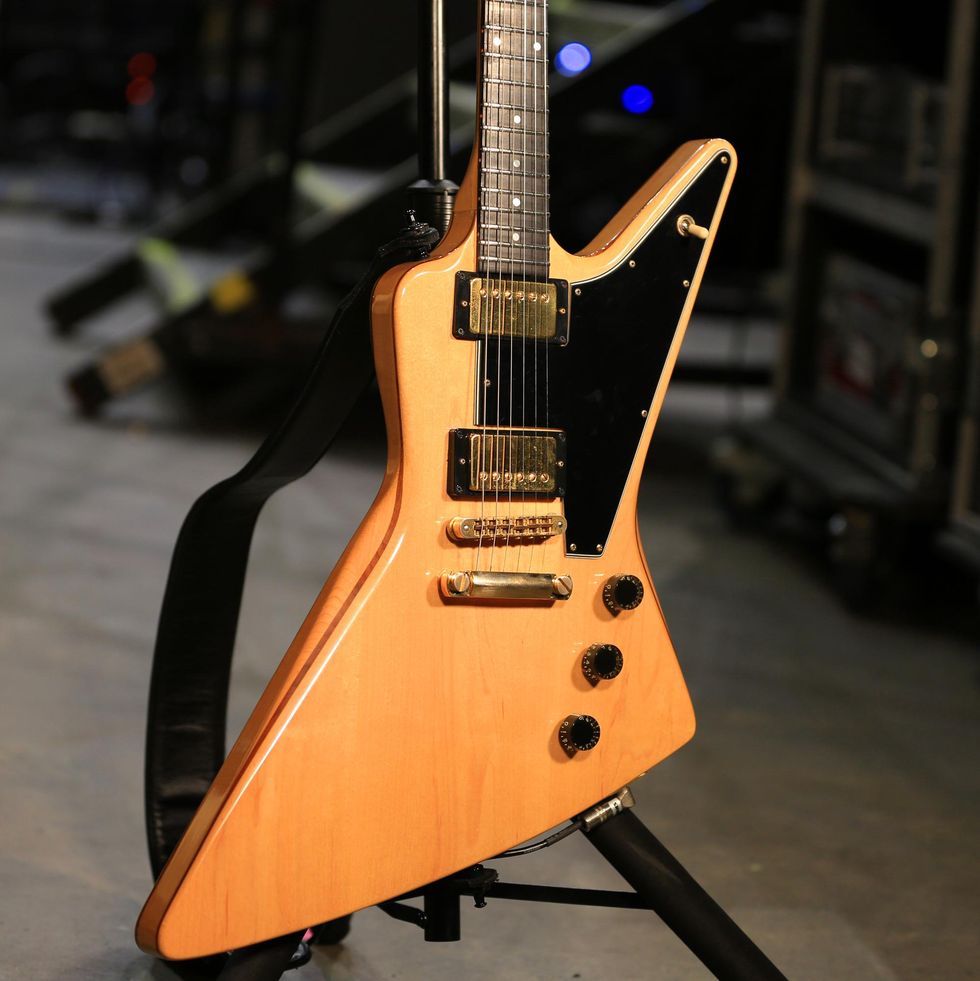
Earlier this year, Claudio eyed this early ’80s Explorer E2 at a shop in Asheville, North Carolina. This gem was in too good a condition for Claudio to drop the coin, so he put it back on the shelf. Little did he know that his wife, Chondra Echert, and guitar tech Kevin Allen combined efforts and scooped the E2 for Claudio’s 44th birthday. This one has a set of Bare Knuckle Nailbombs in it.
It's Yours Now
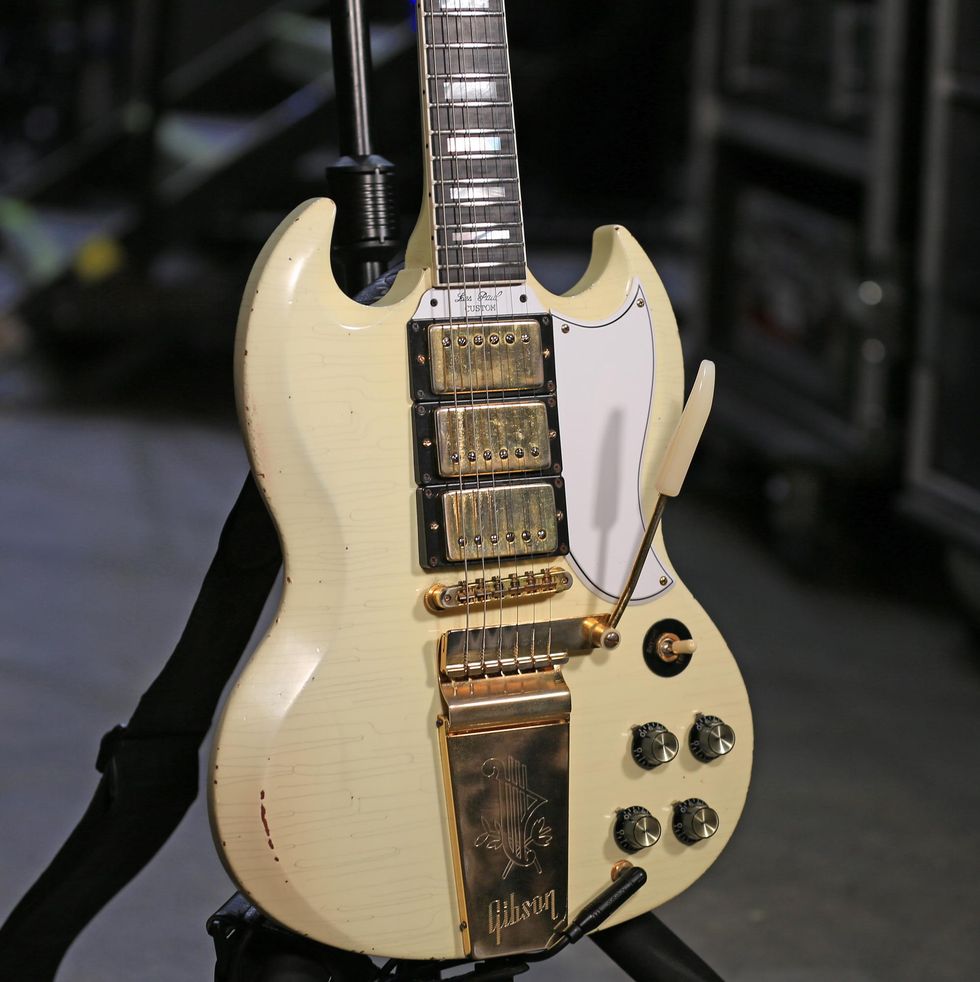
Claudio is unsure if Gibson loaned him or gifted him this 1963 Les Paul SG Custom Reissue with a Maestro Vibrola that was pre-dinged by their Murphy Lab team. He uses this one on “Blood” and has the middle humbucker engaged for an approximated Andy Summers sound.
Double-Oh-My-Heavens
While recording Vaxis–Act I: The Unheavenly Creatures, Claudio encountered a pair of dashing Gibson Customs vying for his attention. He tried to decide between the Flying V and Explorer (which is like having to choose your favorite Bond, between Connery or Craig). Not able to make his mind up, he pulled the trigger and brought this devilish duo into his ranks. Sanchez’s reasoning on the transaction: “I don’t typically buy guitars that often, so I guess I was overdue and bought them both.”
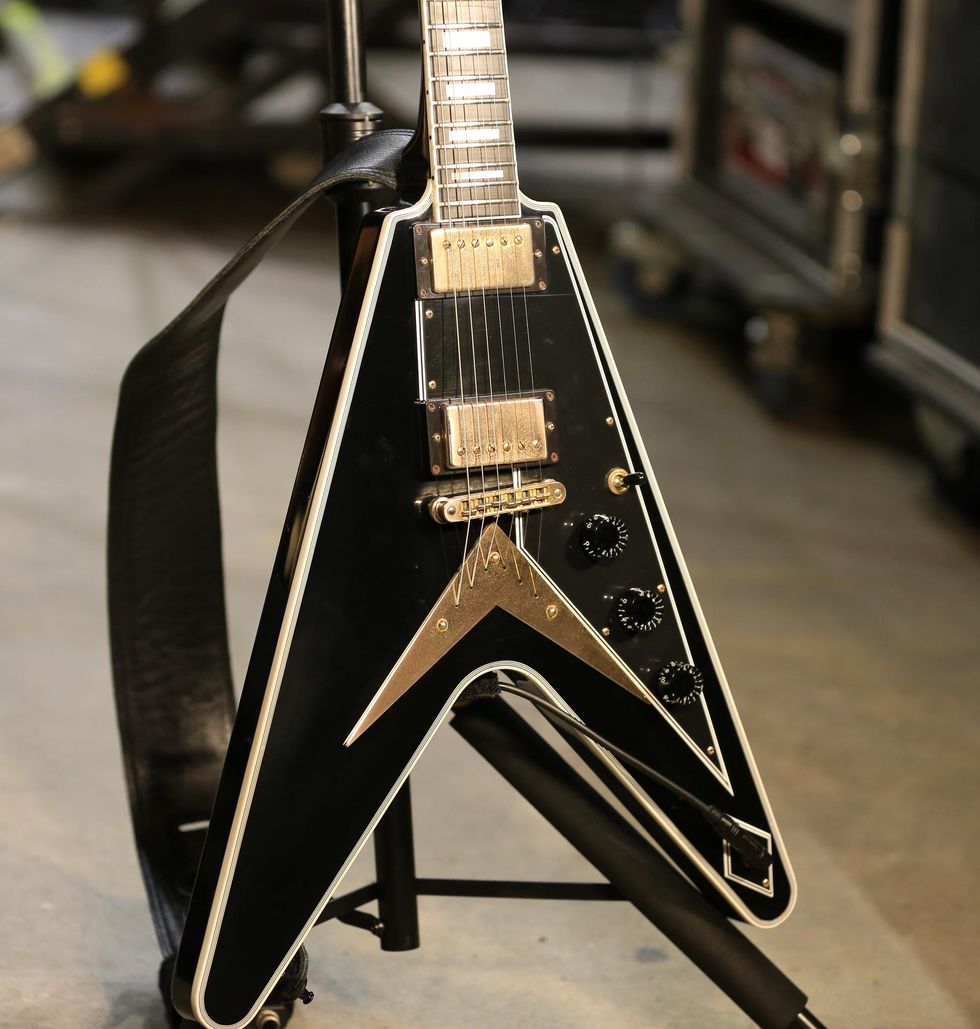
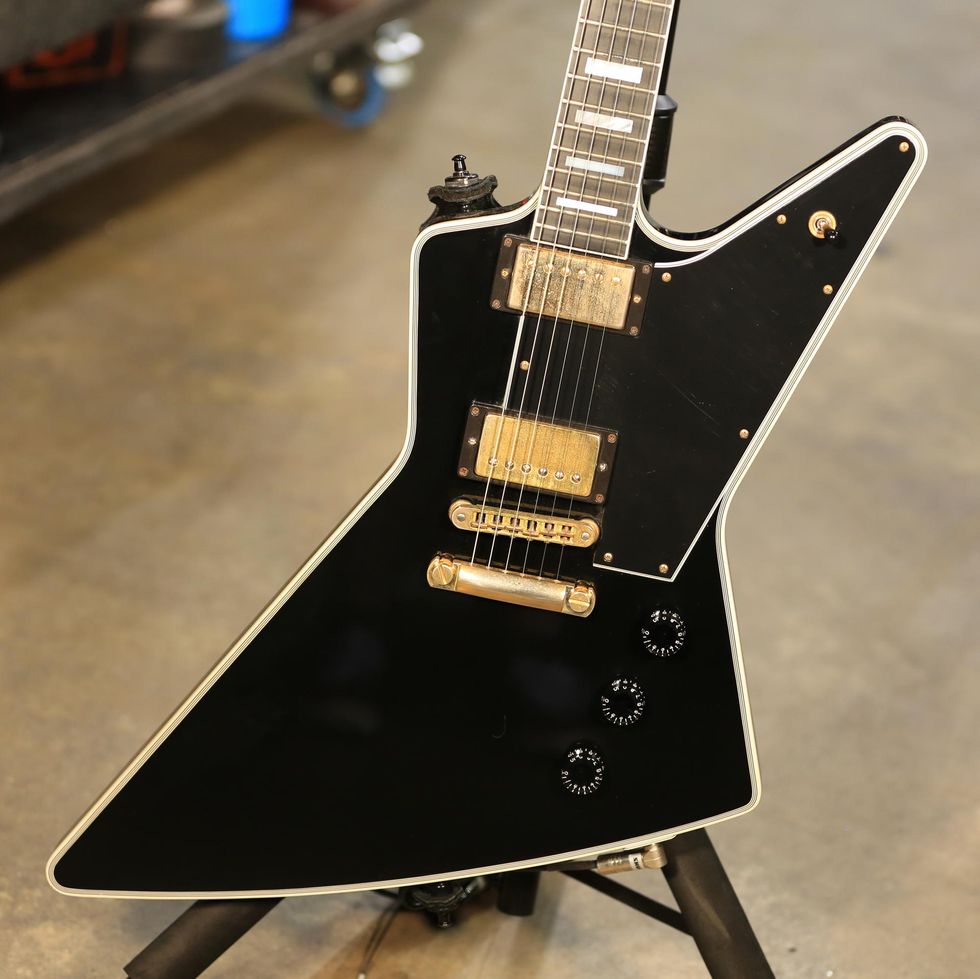
Since the Beginning
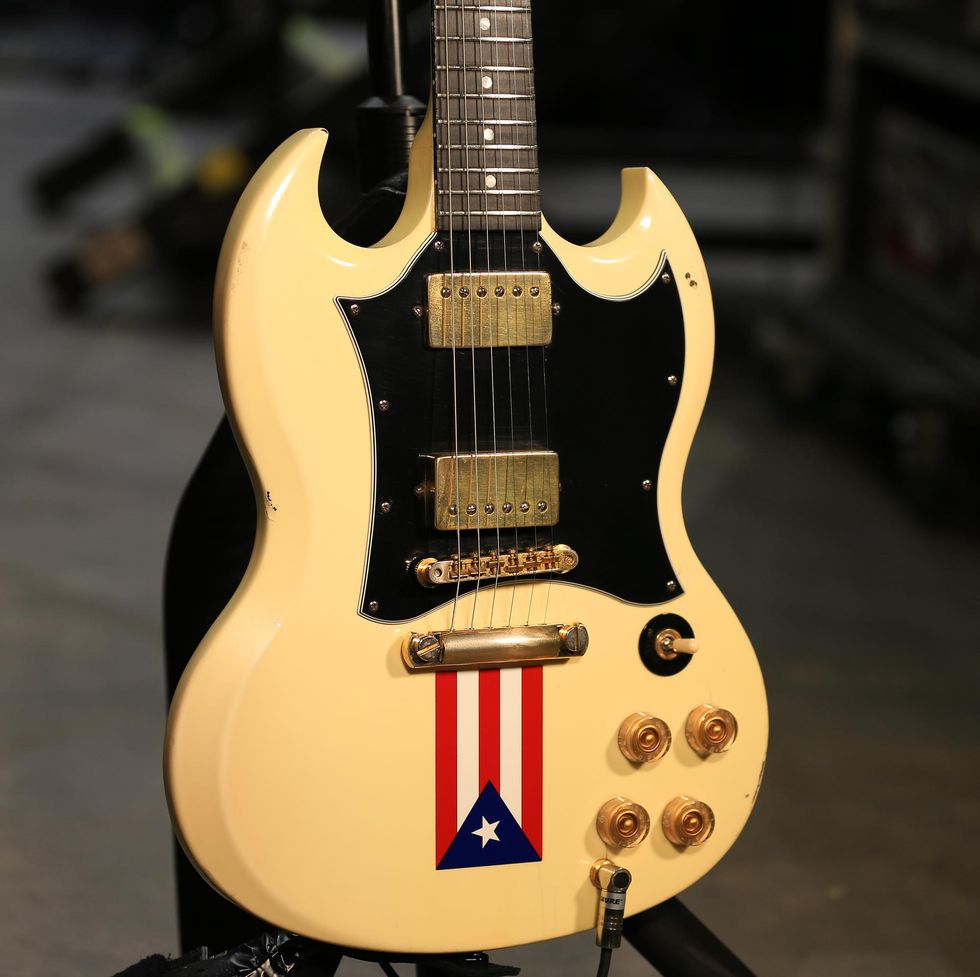
This Gibson SG Special was used on the first Coheed and Cambria tour. Unfortunately, during that initial trek, Sanchez busted the headstock. Unbeknownst to him, this is a relatively normal repair that any experienced guitar tech has encountered. Alas, Sanchez thought the guitar was finished, so he pulled it out of rotation. He lost track of it and years later he saw a social-media post of a guitar that resembled his first SG. He noticed the body’s chipped paint, the Puerto Rican flag behind the tailpiece (getting warmer), and the alarm in his head went off when he noticed the headstock was broke. He reached out to the person and during the band’s next trip through Chicago he made a trade to reacquire this ivory SG Special.
Good as Glue
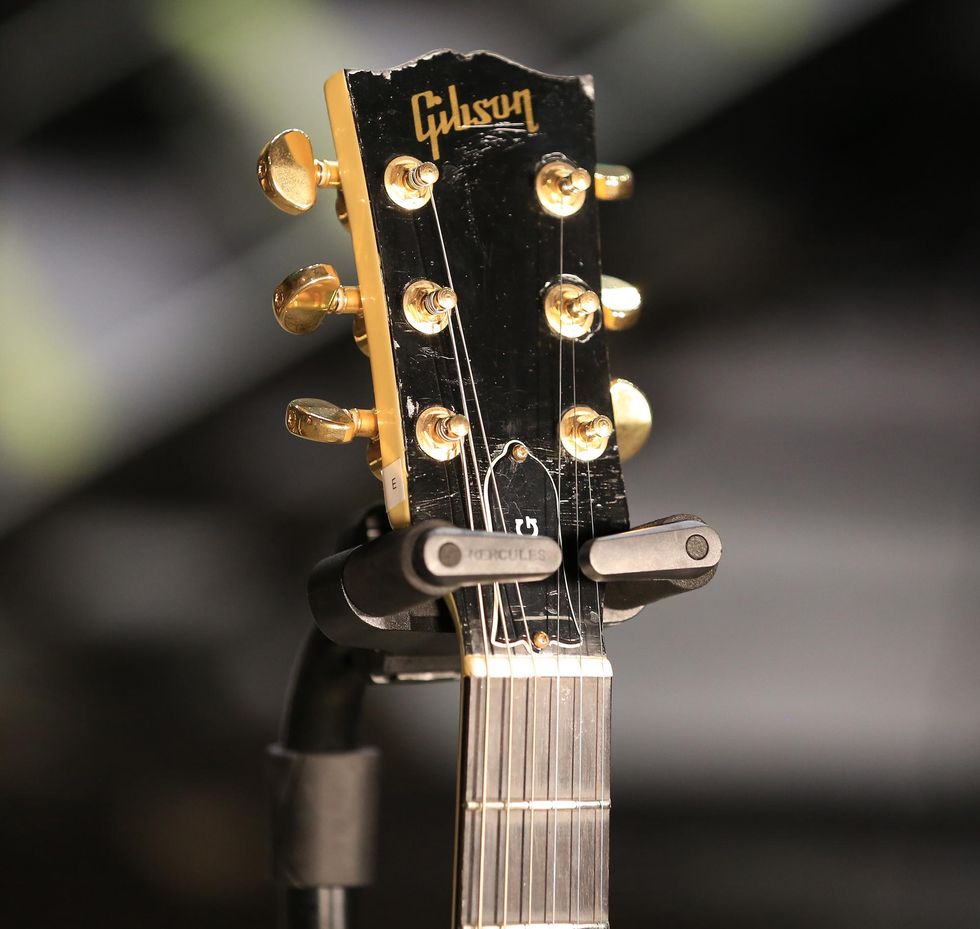
Sanchez’s tech Kevin Allen gave the fallen Gibson some serious TLC and now it makes an appearance every night.
Don’t (or Do) Hold Your Breath
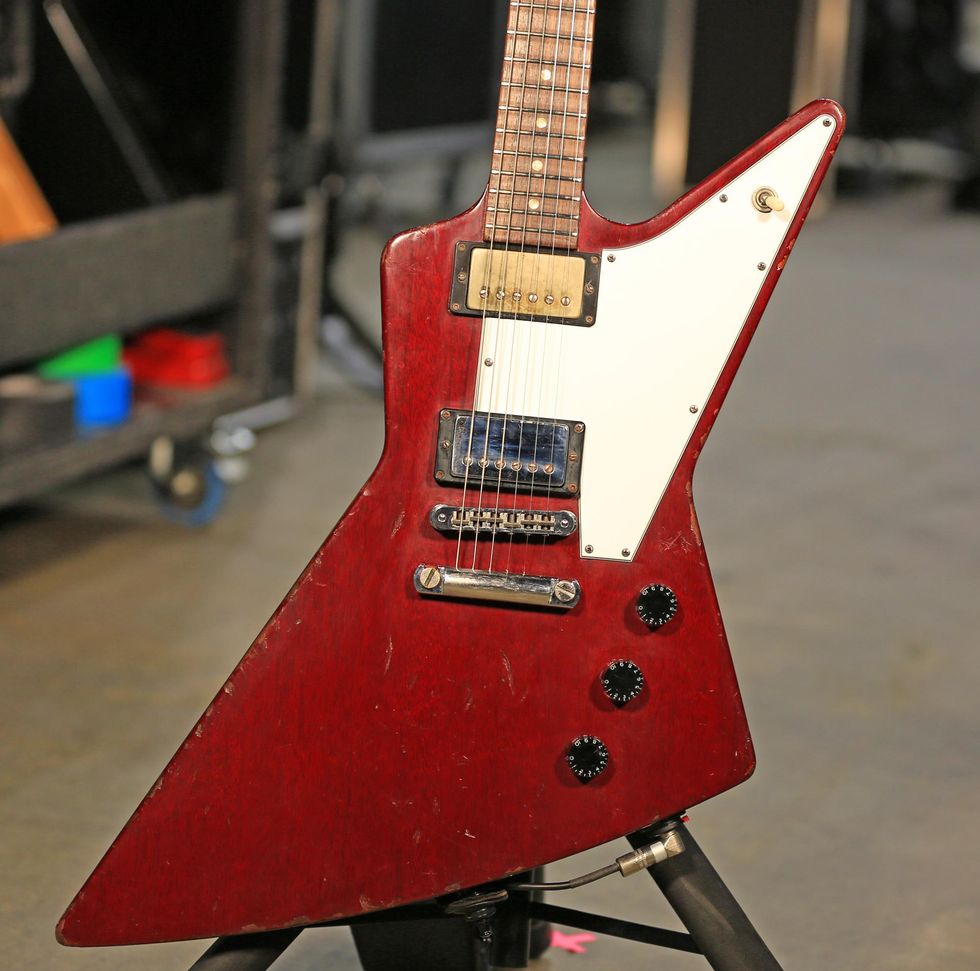
If you’ve seen the band’s video for “The Suffering” off Good Apollo, I’m Burning Star IV, Volume One: From Fear Through the Eyes of Madness, you’ll recognize this 2000s Gibson ’76 Explorer reissue. This was the band’s first album to crack the top 10 of the Billboard 200. In the Rundown, Claudio notes this is his only live guitar that doesn’t have a headstock wound.
A Gift for Ghost
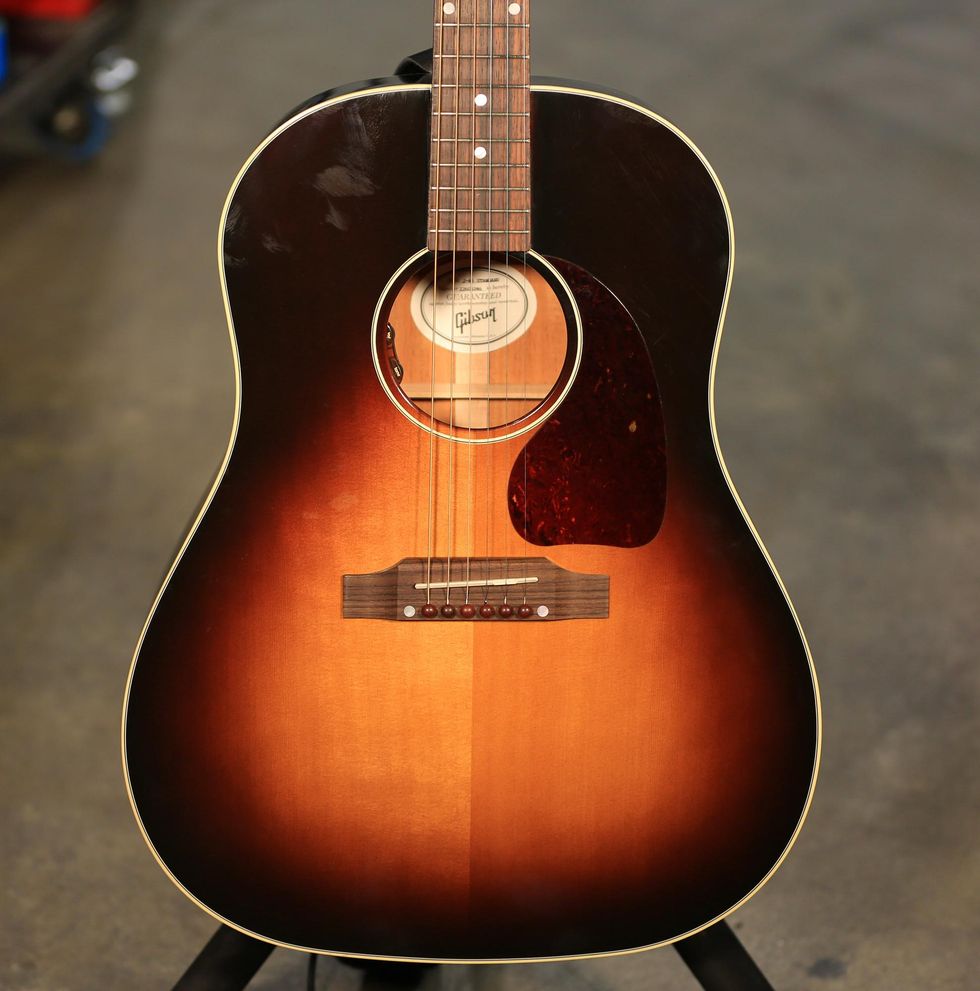
While there was confusion if an earlier Gibson was a gift or a loaner, this J-45 Standard was most certainly given to Claudio. He uses it for the song “Ghost.”
Shred Stand
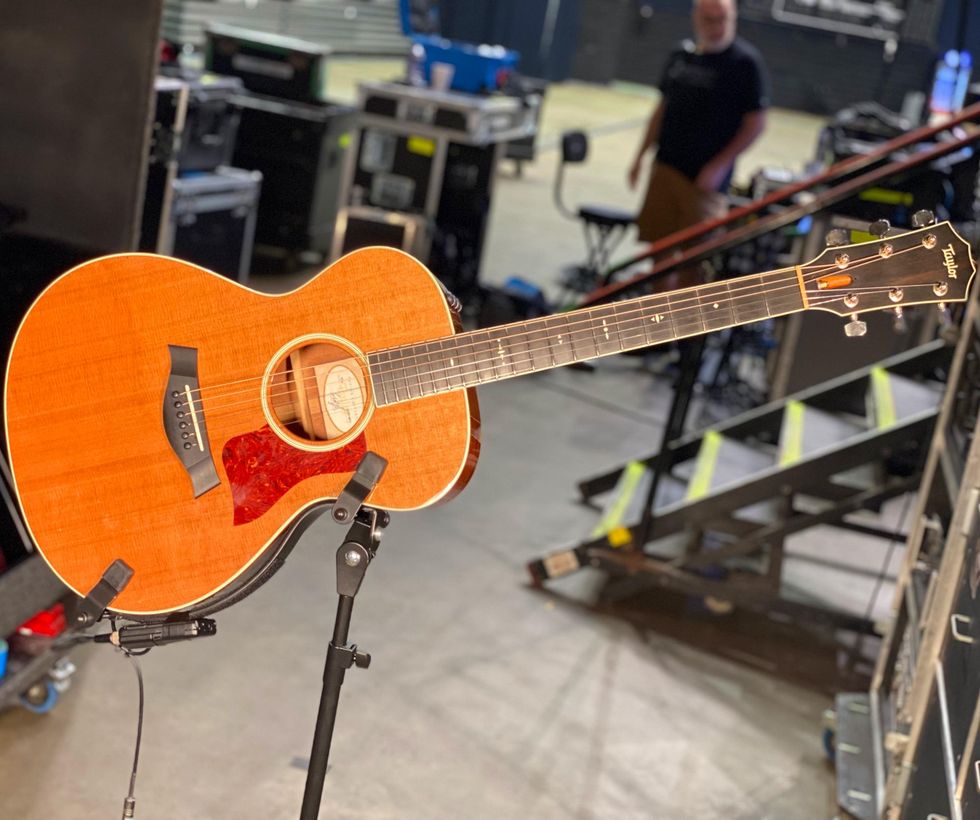
For the top of “Window of the Waking Mind,” Sanchez does his best Yngwie and saddles up on this Taylor 512e. It has a Western cedar top, tropical mahogany back, sides, and neck, ebony fretboard, and Taylor’s Expression System 2 electronics.
Kashmir Clone
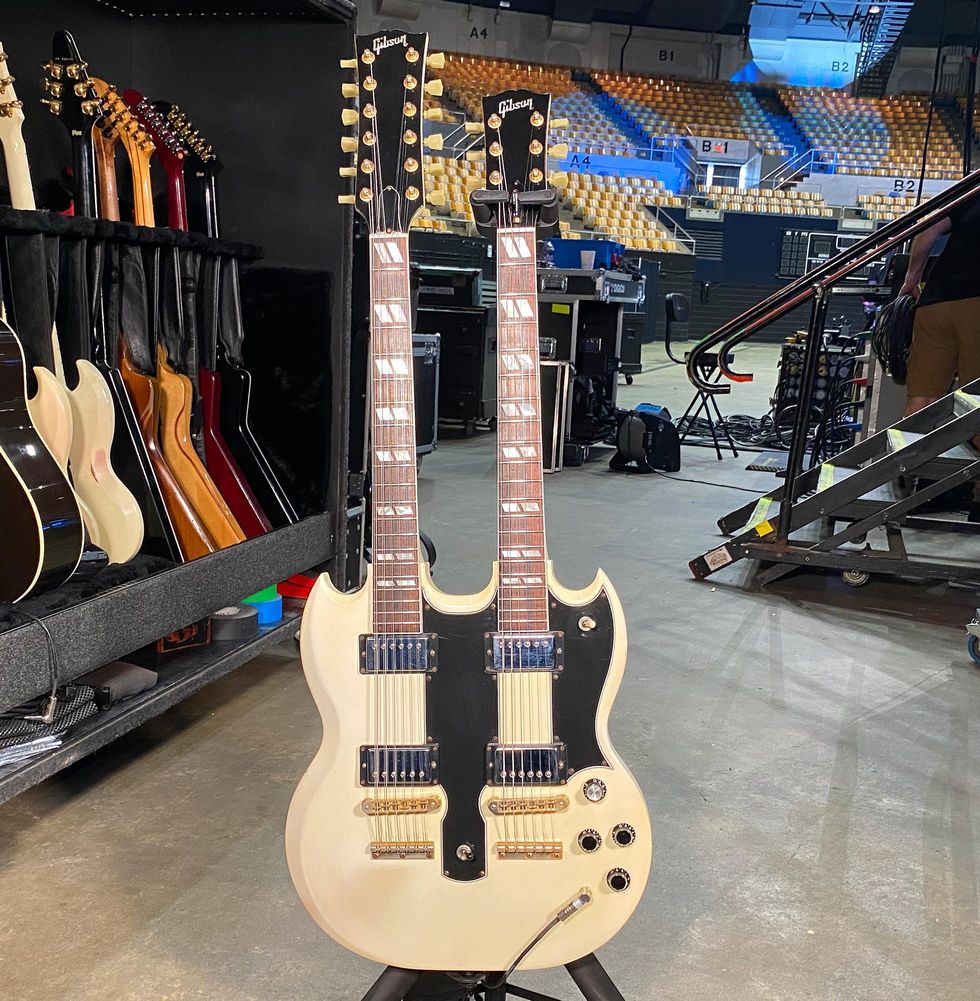
“When I got this thing, it was sort of a gimmick,” concedes Sanchez. “I wrote and recorded ‘Welcome Home’ and acknowledged that there is certainly some ‘Kashmir’ DNA in that song, so I told management ‘let’s show the homage a little clearer and get this Gibson EDS-1275.” This “gimmick” closes out every Coheed show.
Same As It Ever Was
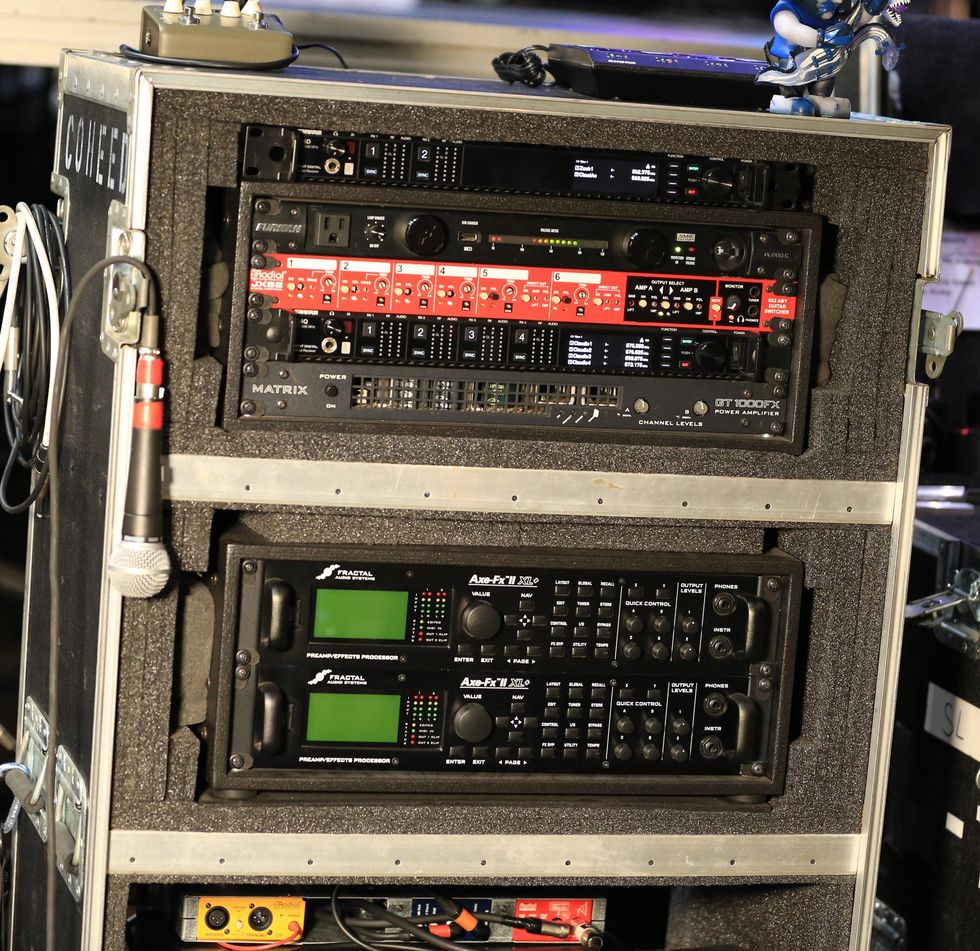
Like Stever, Claudio is still rocking the same Fractal Audio Axe-Fx II from the 2013 Rundown. His most-used patches still have the same heartbeat. His main distortion tone is based on two Marshall Super Leads, with a wah and pitch shifter set to Mission Engineering EP-1 expression pedals onstage. The medium-gain mood is based on an old Orange head with various delays and effects, and his clean is modeled after a Fender brown-panel amp with delay and compressor. He notes in this Rundown that new wrinkles include a patch with chorus and another with fuzz and octave for “Shoulders.”
Like Stever, a Matrix GT1000FX powers the Fractal, a Shure AD4Q wireless unit gives him maximum movement onstage, and a rackmount Radial JX62 handles wireless pack switches for guitar changes.
Sanchez’s Signature Stompbox
For the band’s 20th anniversary, Claudio worked with Wren and Cuff to recreate the sound he used on the band’s earliest work. Sanchez originally had a version VI Electro-Harmonix Big Muff with a Boss SD-1 Super Overdrive running into it for all his solo tones. Wren and Cuff mastermind Matthew Holl put both circuits (using Claudio’s original Muff) into one box and added some extra tweakabilities, including a clipping dial and mod/stock setting for the SD-1 side and a tone bypass for the Muff. The pedal is still in prototype form (as seen here), but they’re hoping to release it before the end of 2022, capping the anniversary for 20 years of Coheed.
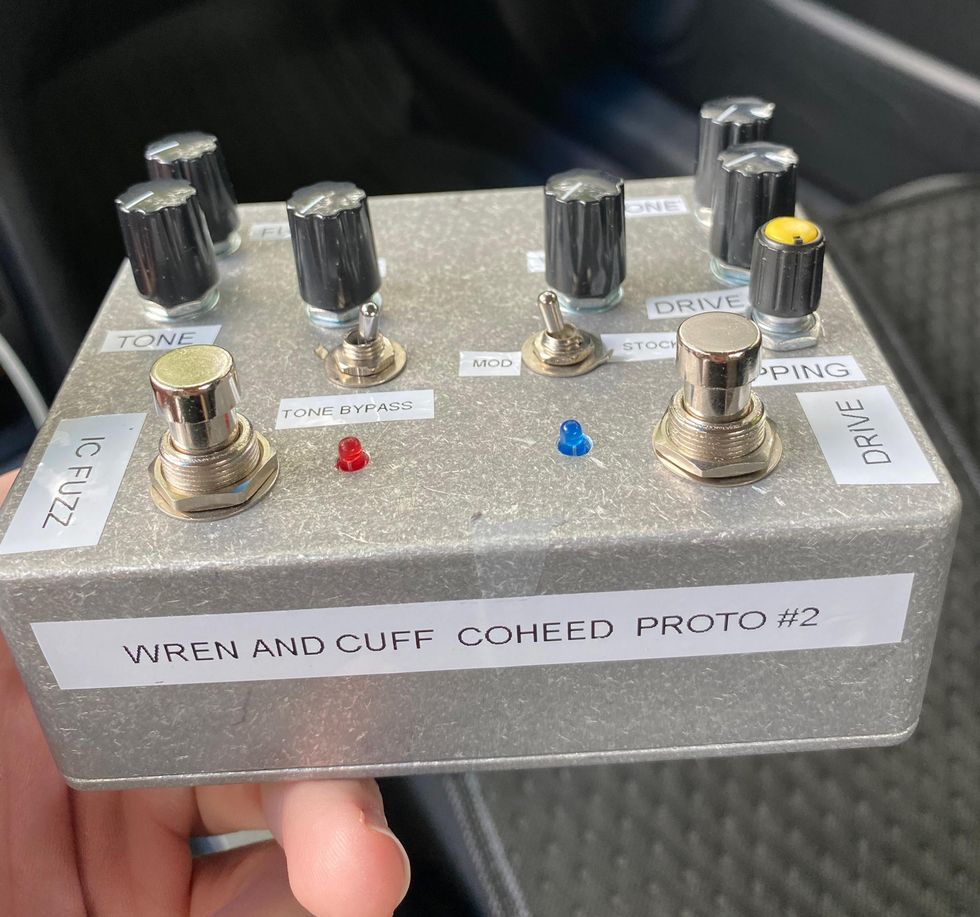
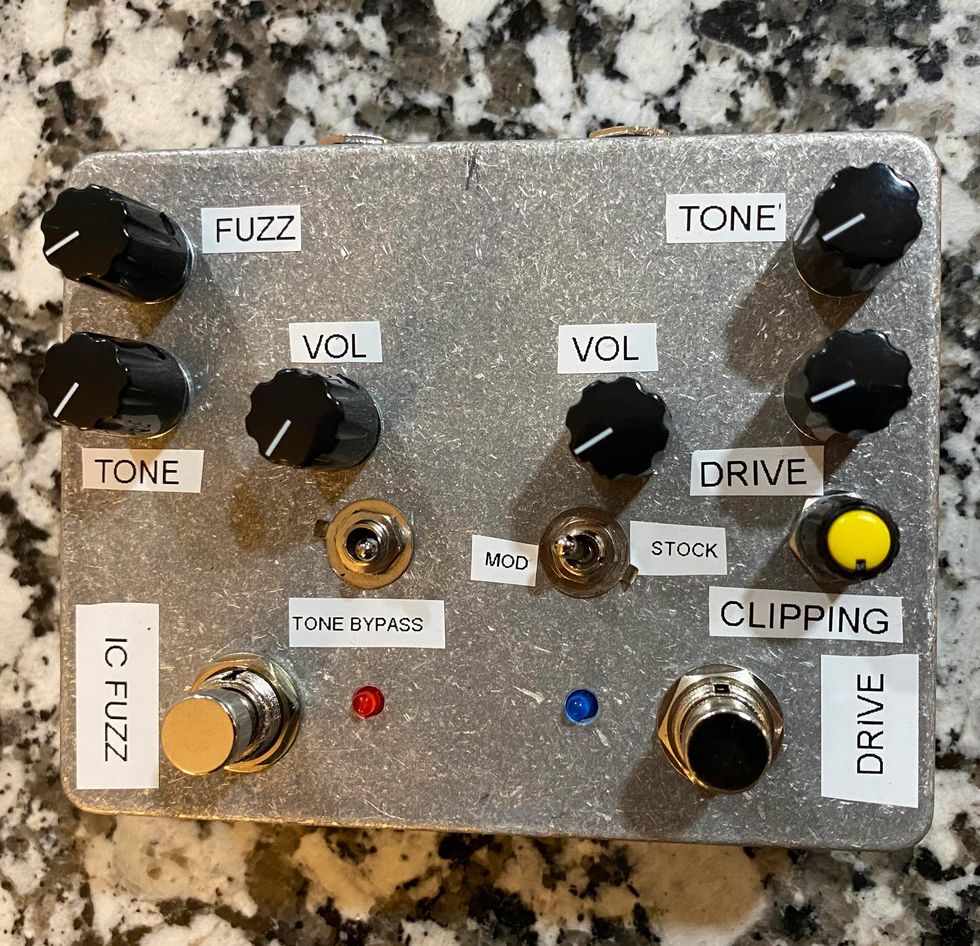
A Teacher’s Muff
How Claudio came to own this Big Muff is a less than prideful story: He stole the pedal from the drawer of his music teacher Bert Hughes. “I was a huge J Mascis fan. I know he used a Big Muff. I had never seen a Big Muff and there it was in front me. I took it,” shrugs Sanchez. Little did he know, Mr. Hughes had acquired that Muff for Claudio, who only found out years later after admitting to his thievery. Upon opening the pedal, the circuit board had “Anna” scribed on its top, so the new Muff-inspired pedal will be called the Anna (as of our publishing date).
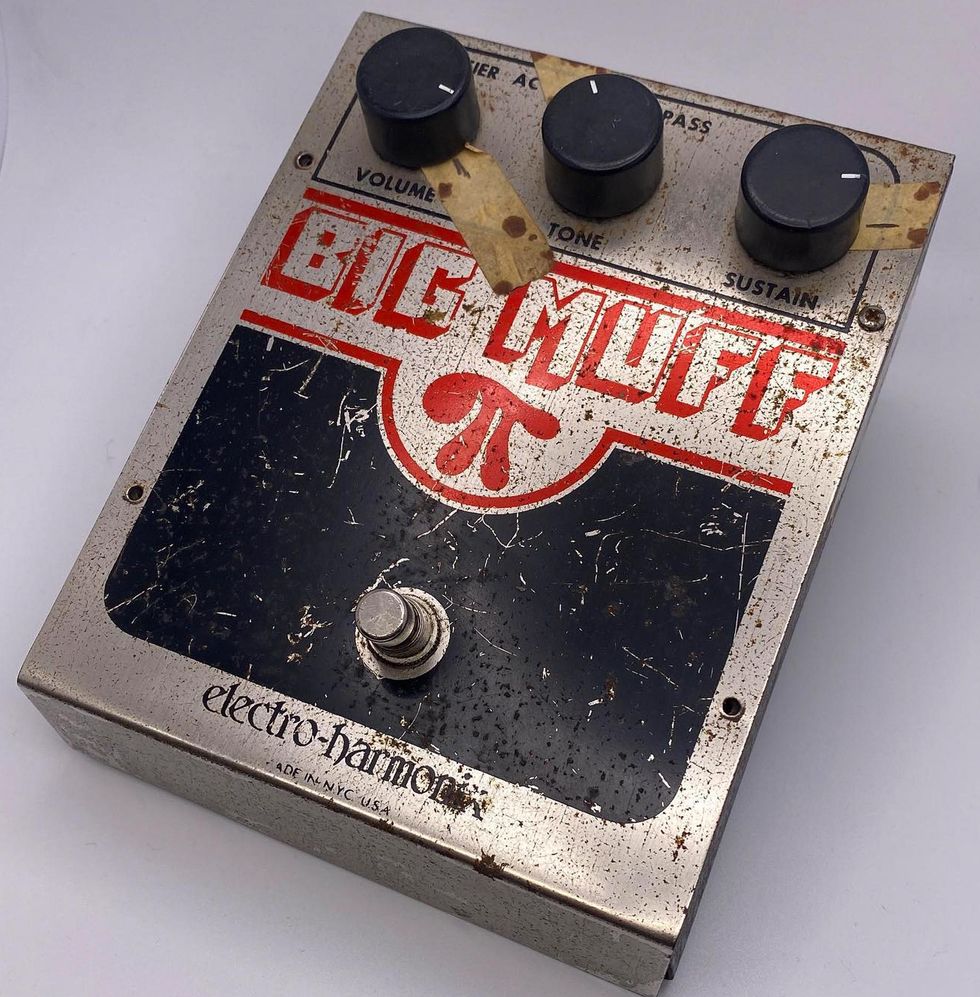
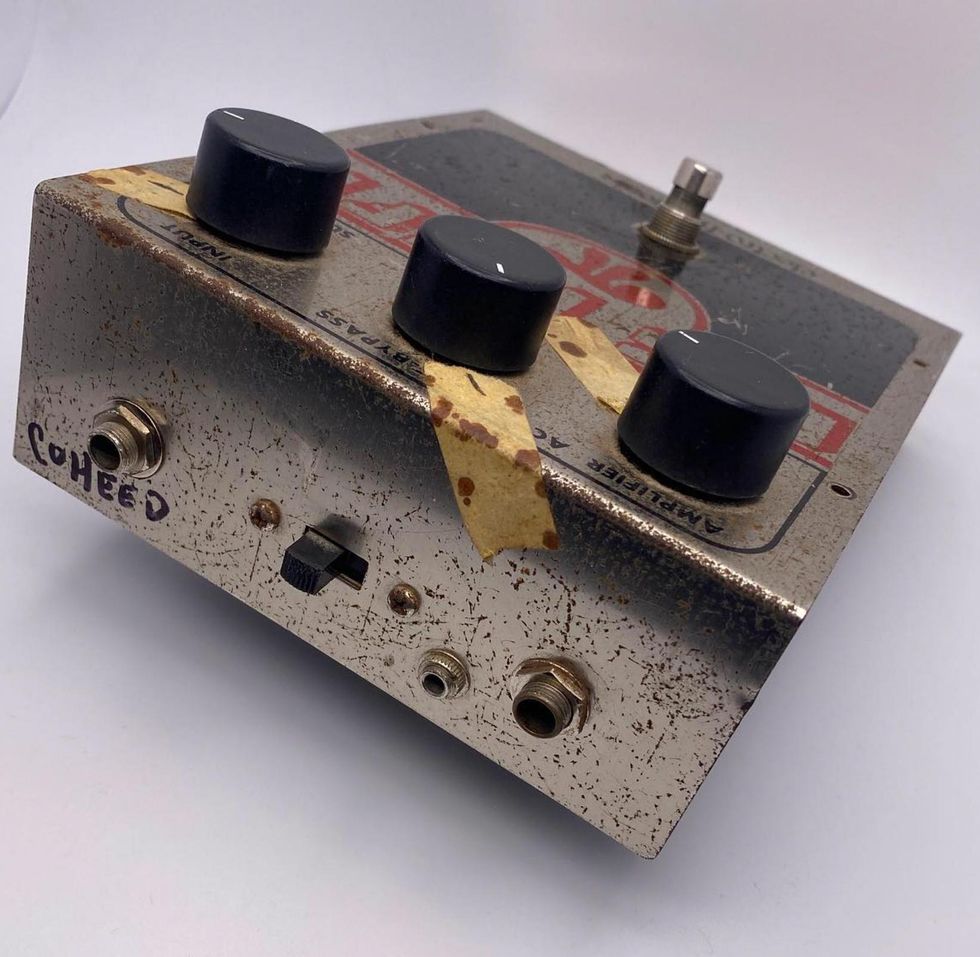
The Black Stallion

Bassist Zach Cooper’s No. 1 is a Nash PB63. He loves this black bomber for its chunky neck profile. He said in the Rundown that if he had to play one bass for the entire gig, it’d be hands-down this one. All his basses have been stripped of the tone circuit and replaced their stock Fralins with his preferred Seymour Duncan Quarter Pound P-Bass pickups. All Cooper’s Nash Ps have custom volume knobs he’s scored from Love My Switches. This one rides in standard all night and takes Ernie Ball Regular Slinky Bass strings (.045–.105).
The Alligator Bass
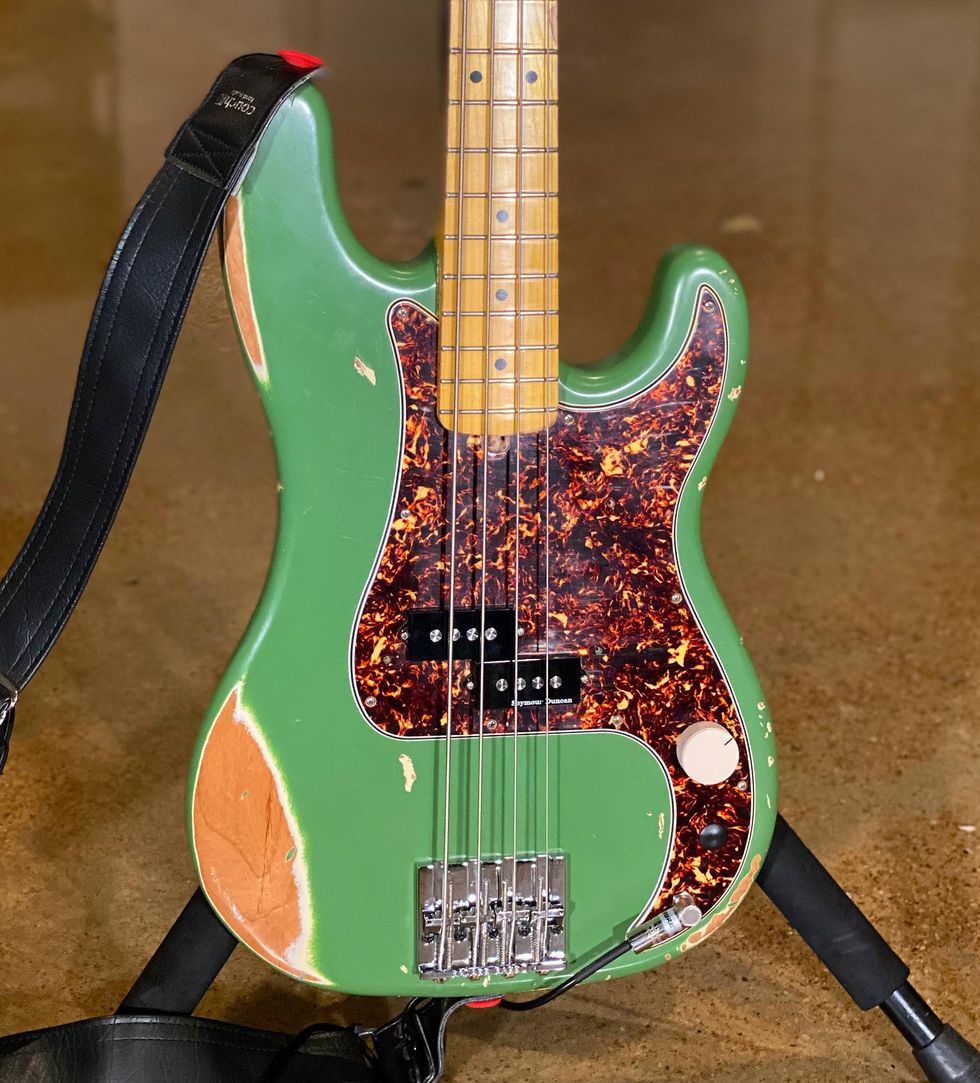
Anyone who’s purchased a Nash instrument knows that they arrive in a brown alligator-skin case. Cooper ordered himself the above Nash PB57 and when it arrived his daughter helped him unbox it. Her gut reaction to its case and the green color was to call it the “alligator bass” and to seal the nickname he put a ’gator sticker on its back near the neck joint. This one stays in E-flat tuning and takes Ernie Ball Power Slinky Bass strings (.055–.110).
Creamsicle
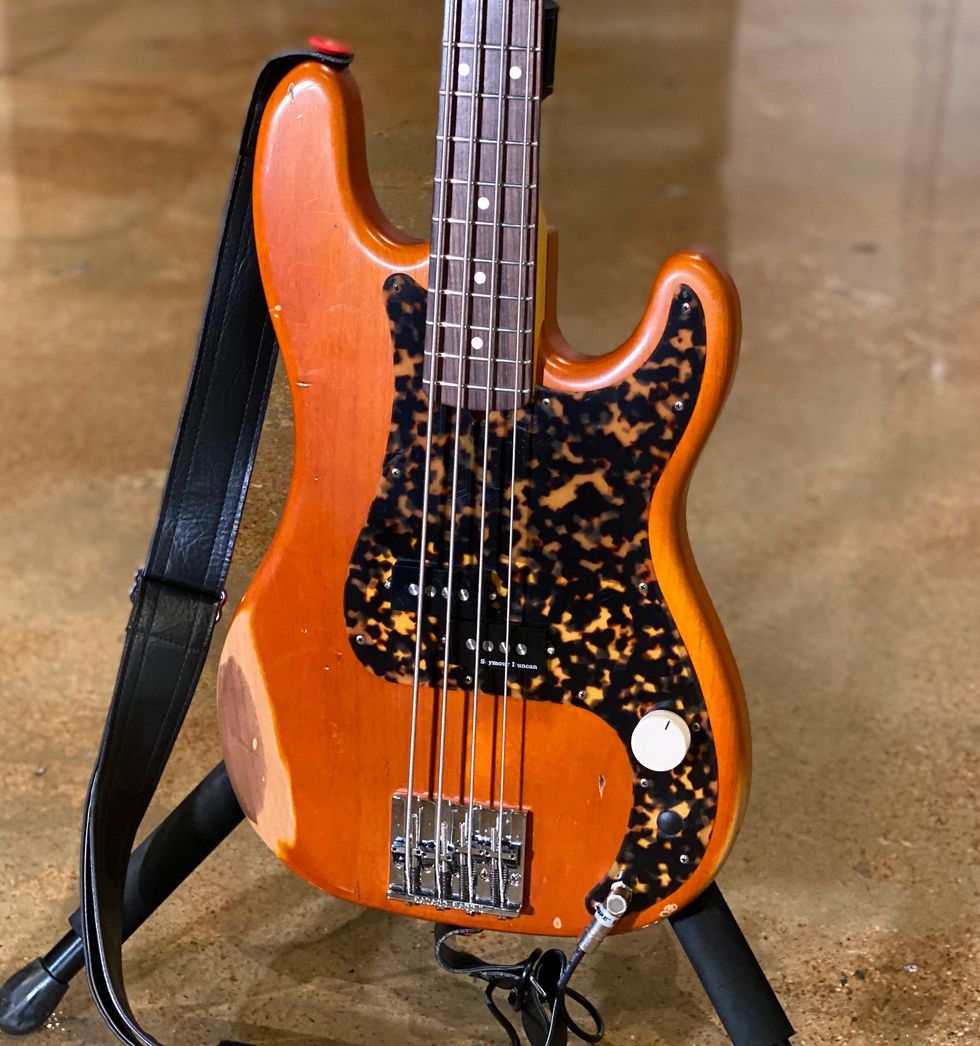
Another Nash PB63 handles songs tuned B-E-A-D and takes a custom set of Ernie Ball Super Slinky Bass 5 strings (.060 –.125). The standard Super Slinky Bass 5 set includes a .040 fifth string, but Cooper only plays 4-string Ps in Coheed.
Amp Anomaly
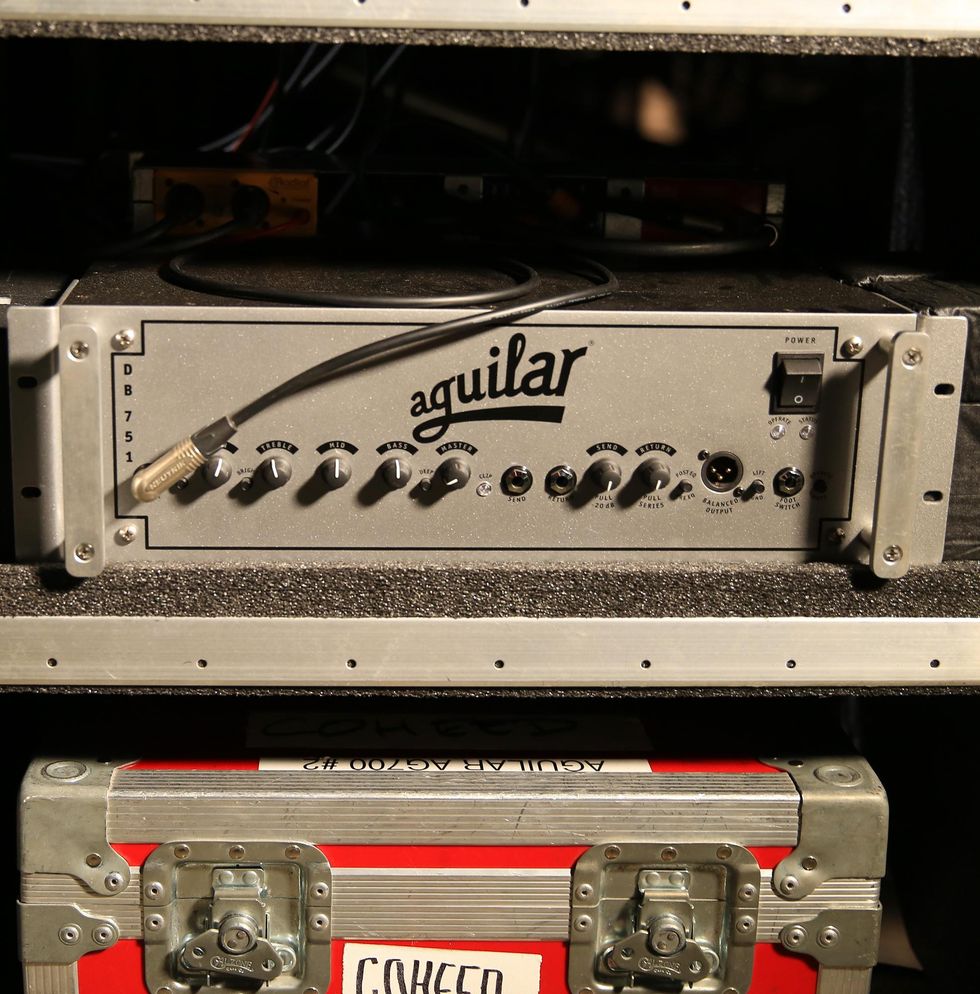
While his guitar-playing colleagues dove deep into the digital realm, Cooper still brings out an amp. His current boom box of choice is an Aguilar DB 751 that runs into a matching Aguilar DB 810 cabinet.
Zach Cooper’s Pedalboard
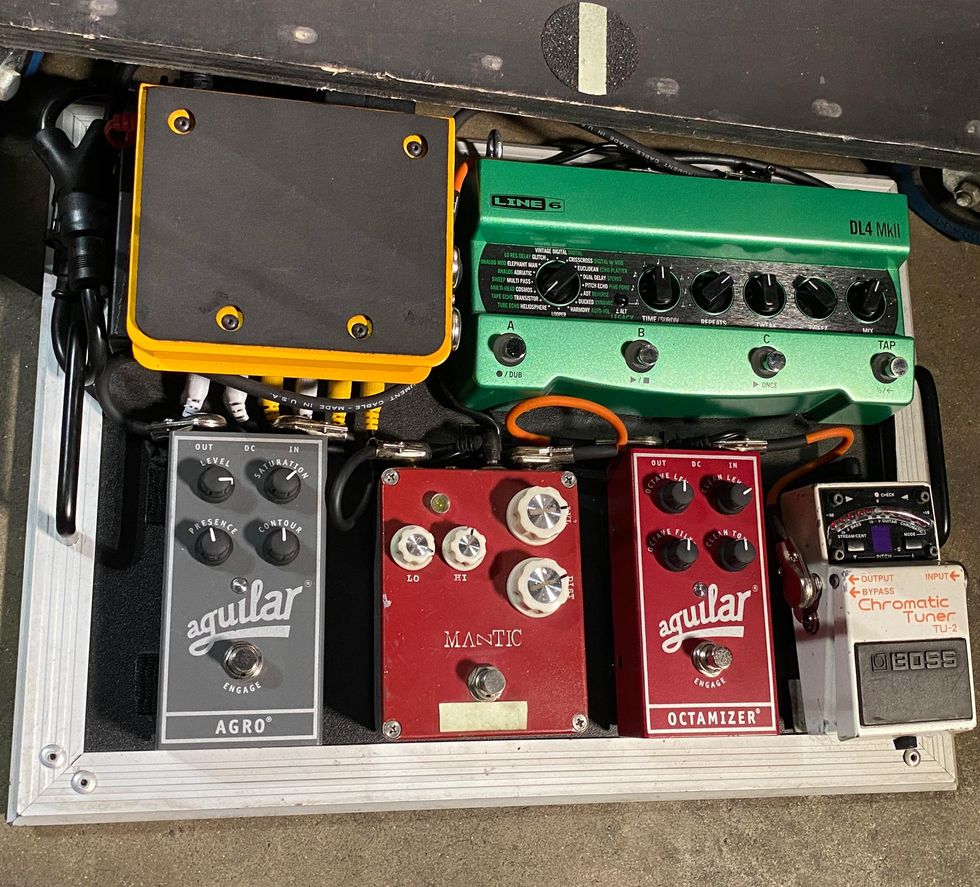
Another rarity for the Coheed crew is a standard pedalboard. Cooper has a fun batch of stomps that includes a duo of Aguilar units—the Agro and the Octamizer, an old Mantic Effects Vitriol, and a Line 6 DL4 MkII. A Boss TU-2 Chromatic Tuner keeps his basses in check.
![Rig Rundown: Coheed and Cambria [2022]](https://www.premierguitar.com/media-library/rig-rundown-coheed-and-cambria-2022.jpg?id=30506405&width=1200&height=675)



![Devon Eisenbarger [Katy Perry] Rig Rundown](https://www.premierguitar.com/media-library/youtube.jpg?id=61774583&width=1245&height=700&quality=70&coordinates=0%2C0%2C0%2C0)
























































